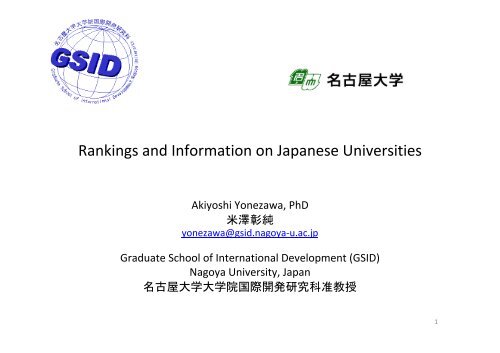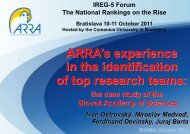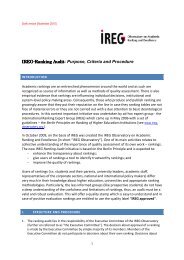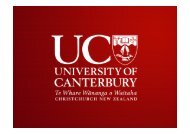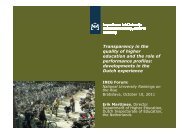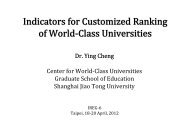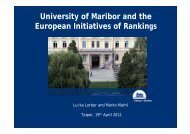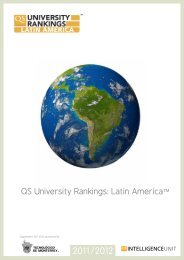Rankings and Information on Japanese Universities - International ...
Rankings and Information on Japanese Universities - International ...
Rankings and Information on Japanese Universities - International ...
- No tags were found...
Create successful ePaper yourself
Turn your PDF publications into a flip-book with our unique Google optimized e-Paper software.
<str<strong>on</strong>g>Rankings</str<strong>on</strong>g> <str<strong>on</strong>g>and</str<strong>on</strong>g> <str<strong>on</strong>g>Informati<strong>on</strong></str<strong>on</strong>g> <strong>on</strong> <strong>Japanese</strong> <strong>Universities</strong>Akiyoshi Y<strong>on</strong>ezawa, PhD米 澤 彰 純y<strong>on</strong>ezawa@gsid.nagoya‐u.ac.jpGraduate School of Internati<strong>on</strong>al Development (GSID)Nagoya University, Japan名 古 屋 大 学 大 学 院 国 際 開 発 研 究 科 准 教 授1
Japan’s HE & <str<strong>on</strong>g>Rankings</str<strong>on</strong>g>• L<strong>on</strong>g history of high attenti<strong>on</strong> to rankings– Hierarchical HE system– Selecti<strong>on</strong> of talented students both at university admissi<strong>on</strong> <str<strong>on</strong>g>and</str<strong>on</strong>g>entrance to the government <str<strong>on</strong>g>and</str<strong>on</strong>g> prestigious companies in housetraining (diploma desease)– Selectivity Score (hensachi 偏 差 値 ) has been widely used since 1970s– Researchers <str<strong>on</strong>g>and</str<strong>on</strong>g> universities became more aware of global positi<strong>on</strong>ingof their research performance from 1980s– Rapid increase of internati<strong>on</strong>al students since 1980s• Two different incentives: student choice for educati<strong>on</strong>(domestic) & research funding (global)• Demographic change <str<strong>on</strong>g>and</str<strong>on</strong>g> globalizati<strong>on</strong>: over supply ineducati<strong>on</strong>, <str<strong>on</strong>g>and</str<strong>on</strong>g> questi<strong>on</strong>ing <strong>on</strong> sustainability ofresearch performance (from 2000s)2
University <str<strong>on</strong>g>Rankings</str<strong>on</strong>g> <str<strong>on</strong>g>and</str<strong>on</strong>g> Student Choice• From <strong>on</strong>e sided selecti<strong>on</strong> by universities to a two waymutual choice between universities <str<strong>on</strong>g>and</str<strong>on</strong>g> students more attenti<strong>on</strong> to educati<strong>on</strong>al c<strong>on</strong>tents <str<strong>on</strong>g>and</str<strong>on</strong>g> studentlife• Kawaijuku: emergence of universities in open entry by2000• Asahi University <str<strong>on</strong>g>Rankings</str<strong>on</strong>g> (1994‐) have providedaround 80 indicators in order to widen the perspective<strong>on</strong> the universities <strong>on</strong> behalf of students <str<strong>on</strong>g>and</str<strong>on</strong>g> theirparents; <str<strong>on</strong>g>and</str<strong>on</strong>g> to overcome an over reliance of a singleselectivity indicator hensachi (avoiding comprehensiverankings based <strong>on</strong> multiple indicators that have str<strong>on</strong>gcorrelati<strong>on</strong> to the selectivity score)3
Indicators <str<strong>on</strong>g>and</str<strong>on</strong>g> topics appearing inAsahi University <str<strong>on</strong>g>Rankings</str<strong>on</strong>g> 2012• <str<strong>on</strong>g>Informati<strong>on</strong></str<strong>on</strong>g> disclosure• Yield rate in admissi<strong>on</strong>• Dropout rate• Review by university presidents• Review by high schools• Administrative staff• World university rankings• Tuiti<strong>on</strong> fees• Learning envir<strong>on</strong>ments• Newly established universities• Local public universities• Women’s universities• Religious universities• Small sized universities• University libraries• University repository• Internati<strong>on</strong>al volunteer• C<strong>on</strong>tests• Study abroad programs• Rate of proceeding to a graduateprogram• Number of doctoral degrees issued• Share of female students• Share <str<strong>on</strong>g>and</str<strong>on</strong>g> number of internati<strong>on</strong>alstudents• <strong>Universities</strong> from which the universitypresidents graduated• Newly recruited faculty members• Average age of faculty members• Share of alumni of faculty members• Share of faculties with doctoraldegrees• Share <str<strong>on</strong>g>and</str<strong>on</strong>g> number of female faculties• Share <str<strong>on</strong>g>and</str<strong>on</strong>g> number of internati<strong>on</strong>alfaculties• Share of adult students• Participati<strong>on</strong> in parents meetings• Student life• Appearance in fashi<strong>on</strong> magazines• Job placement support staff• Internship• Pass to examinati<strong>on</strong>s for civil servantsteachers• Professi<strong>on</strong>al qualificati<strong>on</strong>s (lawyers,accountants, etc.)• Highly cited articles• Citati<strong>on</strong> index• Articles listed in Scopus• Articles in Chemical Abstracts• Articles in Nature <str<strong>on</strong>g>and</str<strong>on</strong>g> Science• Articles in internati<strong>on</strong>al journals ofec<strong>on</strong>omics• Academic awards• Patents• Research grants from the nati<strong>on</strong>algovernment• External research funds• Research grants from foundati<strong>on</strong>s• Governmental subsidies to privateuniversities• Salaries of faculty members• Appearance in media• Movies <str<strong>on</strong>g>and</str<strong>on</strong>g> TV drama shootings <strong>on</strong> thecampuses• Members of governmental councils• Alumni recruiters at companies• Alumni am<strong>on</strong>g Diet members• Alumni am<strong>on</strong>g the presidents ofenterprises• Alumni am<strong>on</strong>g sport players• Alumni am<strong>on</strong>g novelists• Alumni am<strong>on</strong>g female TV announcers• Alumni members• Number of applicants• Applicants / admitted students• Transiti<strong>on</strong> students• Returnee students from overseas4
• College Management by Recruit Ltd. : provide amore in‐depth view of various universities touniversity managers <str<strong>on</strong>g>and</str<strong>on</strong>g> administrators, <str<strong>on</strong>g>and</str<strong>on</strong>g>then high school students– Student satisfacti<strong>on</strong> surveys with various indicators in1997, 1999, <str<strong>on</strong>g>and</str<strong>on</strong>g> 2001– <str<strong>on</strong>g>Rankings</str<strong>on</strong>g> <strong>on</strong> the universities’ competitiveness fordeveloping the br<str<strong>on</strong>g>and</str<strong>on</strong>g> image based <strong>on</strong> high schoolstudent surveys (every two years since 2003)• <str<strong>on</strong>g>Rankings</str<strong>on</strong>g> ‘Daigaku no Jitsuryoku (The Real Powerof <strong>Universities</strong>)’ by Yomiuri Shinbun (2008‐)– Focus more <strong>on</strong> the quality of educati<strong>on</strong> provisi<strong>on</strong>,teaching improvement, curriculum design, etc.– Publish the data <str<strong>on</strong>g>and</str<strong>on</strong>g> rankings in combinati<strong>on</strong> with thearticles <strong>on</strong> various types of universities5
Indicators appearing in YomiuriShimbun’s Daigaku no Jitsuryoku• Students/student quota set by thegovernments• Faculty/other academic staff• Full‐time academic staff/part‐timeacademic staff• Admitted students in variousadmissi<strong>on</strong> processes• Dropout rate• Graduate rate• Remedial educati<strong>on</strong> programs• Remedial classes <strong>on</strong> <strong>Japanese</strong>language• Remedial classes <strong>on</strong> Englishlanguage• Classes for TOEIC examinati<strong>on</strong>• Compulsory class of mathematics• Project‐based learning• Group work• Classes with debate sessi<strong>on</strong>s• Class size of first year studentseminars• Class size of language educati<strong>on</strong>• Class size of seminars• Minor or sub‐major system <str<strong>on</strong>g>and</str<strong>on</strong>g>credits• Job placement support by alumniassociati<strong>on</strong>s• Capacity of dormitories• Notice of academic grades toparents• Requirement of undergraduatethesis• Self‐evaluati<strong>on</strong> score6
University <str<strong>on</strong>g>Rankings</str<strong>on</strong>g> for Research Performance(impact of world university rankings)• World university rankings as a tool for obtaininginternati<strong>on</strong>al recogniti<strong>on</strong>• <strong>Universities</strong> directly involved in internati<strong>on</strong>al competiti<strong>on</strong>tend to be limited to (mainly public) research universitiesbased <strong>on</strong> STEM fields in Japan (recently to some degree insocial sciences)• <strong>Japanese</strong> nati<strong>on</strong>al (public) universities relying heavily <strong>on</strong>the public budget of the nati<strong>on</strong>al government both inoperati<strong>on</strong>al expenditures <str<strong>on</strong>g>and</str<strong>on</strong>g> basic research project funds,<str<strong>on</strong>g>and</str<strong>on</strong>g> external research funds from industries based in Japan<strong>Universities</strong> have also strategically utilized world universityrankings to attract attenti<strong>on</strong> from the government <str<strong>on</strong>g>and</str<strong>on</strong>g>domestic society7
• 47% of nati<strong>on</strong>al university managers resp<strong>on</strong>ded that theyreferred to world university rankings as an indicator whenmanaging their universities (Y<strong>on</strong>ezawa, Akiba, & Hirouchi,2009)– Tohoku University: ambiti<strong>on</strong> to be a “world leading” university rankedam<strong>on</strong>g the top 30 in the world (2007)– Hitotsubashi University: benchmarking exercise with the L<strong>on</strong>d<strong>on</strong>School of Ec<strong>on</strong>omics <str<strong>on</strong>g>and</str<strong>on</strong>g> Political Sciences (LSE) (2009)• Private universities: <strong>on</strong>ly two (Waseda & Keio) ranked in QSbased <strong>on</strong> str<strong>on</strong>g reputati<strong>on</strong>• Objecti<strong>on</strong>s to ranking methodologies:– Indicators <strong>on</strong> reputati<strong>on</strong> by employers in QS rankings (Kobayashi2005)– Collective acti<strong>on</strong> by Research University 11 (RU11) towards newranking methodology by THE & Thomps<strong>on</strong> Reuters (2010‐2011)• Participati<strong>on</strong> to U‐map project by University of Tokyo, &stress the value of benchmarking exercises (Kobayashi)8
Source: website of RU119
<str<strong>on</strong>g>Rankings</str<strong>on</strong>g> <strong>on</strong> University Finance• High attenti<strong>on</strong> from university managers, variousindustries <str<strong>on</strong>g>and</str<strong>on</strong>g> business professi<strong>on</strong>als (esp. in last 10years)– Bankers: pay attenti<strong>on</strong> to the sustainability of lessprestigious, private universities in particular, under theoversupply c<strong>on</strong>diti<strong>on</strong> of the student market– Top universities (public & private) face the necessity ofattracting more investment from the industrial <str<strong>on</strong>g>and</str<strong>on</strong>g>business world in order to strengthen their educati<strong>on</strong>al<str<strong>on</strong>g>and</str<strong>on</strong>g> research profile under fierce global competiti<strong>on</strong> (biggap with US top universities)– General public (or parents): some private universities lostproperty after experiencing financial investment failuredue to the ec<strong>on</strong>omic recessi<strong>on</strong> of 200810
Indicators utilized by Toyo Keizai• Expenditure for educati<strong>on</strong> <str<strong>on</strong>g>and</str<strong>on</strong>g> research per student• Property of the library (books, journals, multimedia)• Research Grant from Japan Society of Promoti<strong>on</strong> of Science• Student‐Faculty ratio• Ratio of students who acquired jobs up<strong>on</strong> graduati<strong>on</strong>• Number of senior managers of stock companies at the graduatelevel• Annual income of 30‐year‐olds am<strong>on</strong>g alumni• Ratio of increase/decrease of applicants• Ordinary income ratio• Share of external funds (except tuiti<strong>on</strong> fees <str<strong>on</strong>g>and</str<strong>on</strong>g> governmentalsupport for operati<strong>on</strong>al expenditure) within the total income• Capital Adequacy Ratio11
Nati<strong>on</strong>al Government <str<strong>on</strong>g>and</str<strong>on</strong>g> University <str<strong>on</strong>g>Rankings</str<strong>on</strong>g>(ambivalent attitude)• Basically critical of the hierarchical stratificati<strong>on</strong> based <strong>on</strong> thestudent selectivity scores (before emergence of world universityrankings)• Positively viewed a campaign by the leaders of top nati<strong>on</strong>aluniversities <strong>on</strong> further investment in university educati<strong>on</strong> researchin line with the government's policy <strong>on</strong> strengthening investment inthe knowledge ec<strong>on</strong>omy– Ranking of the University of Tokyo in the Gourman Report wasreferred to at the Diet <strong>on</strong> three occasi<strong>on</strong>s in the 1990s– Toyama Report: idea to foster around 30 “world‐class” universities (nodirect menti<strong>on</strong>ing <strong>on</strong> rankings themselves)• Emergence of World University <str<strong>on</strong>g>Rankings</str<strong>on</strong>g> (2003‐): utilized asbenchmarks in policy debates by political parties <str<strong>on</strong>g>and</str<strong>on</strong>g> thegovernment (Ministry of Finance vs Ministry of Educati<strong>on</strong> <str<strong>on</strong>g>and</str<strong>on</strong>g>Science.. [MEXT])12
C<strong>on</strong>clusi<strong>on</strong>: A New Era of Regi<strong>on</strong>alCollaborati<strong>on</strong> in Asia?• <strong>Universities</strong> & government: Yes– the gap of ranking positi<strong>on</strong>s between <strong>Japanese</strong> universities<str<strong>on</strong>g>and</str<strong>on</strong>g> other Asian universities has nearly disappeared collaborati<strong>on</strong> am<strong>on</strong>g Asian universities as equal partners ineducati<strong>on</strong> <str<strong>on</strong>g>and</str<strong>on</strong>g> research benchmark exercises am<strong>on</strong>g Asian universities is becoming moreactive (but not collaborative in regi<strong>on</strong>al level seen in Europe yet)• Rankers: not yet???– Different historical c<strong>on</strong>text (esp. in Japan?)– Some (but still minor) arguments for developinginternati<strong>on</strong>al rankings under our own (still nati<strong>on</strong>al in caseof Japan) sovereignty13
Thank you!ありがとうございます!非 常 感 謝 !14


